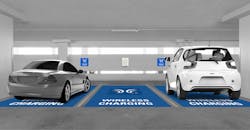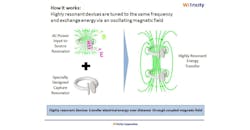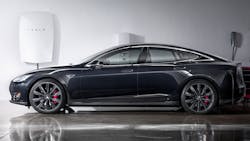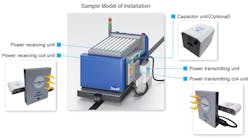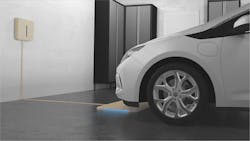Wireless Tech Leading Charge to Transportation Revolution
The automotive industry is the engine of manufacturing, with half of all companies listed on the Dow Jones Industrial Average depending on it for revenue, according to the Auto Alliance. The average car has about 30,000 parts, and each part needs to get manufactured, packaged, shipped, and inserted into the assembly process. It's complicated stuff, and it's an amazing human accomplishment that car manufacturing has been pretty much perfected over the last century or so.
You should all be very proud. But brace yourself, manufacturing industry. There a reboot coming.
As with anything in life, once you get really good at something, from parenting to politics, all the damn rules change. With cars, it's the actual engine that's changing. Adios internal combustion; hello electric power.
Motor Trends called Tesla's Model 3 the most important vehicle of the century. Every carmaker is going electric, and by 2020, the number of electric vehicles sold in America could break 10%, according to Pricewater Cooper (10%) and Deutsche Bank projections (11%).
Disruption doesn’t even begin to describe what will happen to the current landscape. Turning fossil fuel into energy takes a ton (or more) of parts, from the gas tank to the fuel pump to the pistons in the engine. Then you have the spark plugs, belts and muffler, parts that wear over time and need to be replaced at least once over the life of car. Nearly every car parts manufacturer, supplier and sub-supplier will take a major hit if they don’t make some major changes.
Of course anything to do with circuits and batteries should be a safe bet, but if you really want to prepare for the long journey ahead, thinking how these batteries get charged, specifically without any wires, may be the right avenue to go down.
This way is new and unexplored by most, but for WiTricity, (featured here last year and NED 2017 Innovation Award winner), it's a familiar road. Using magnetic resonance, WiTricity's Drive 11 can safely charge any device it's coupled to from a distance of up to 25 cm. Further distances have been demonstrated, but require a stupid amount of energy.
The benefit of magnetic resonance, similar but not identical to the magnetic induction the new iPhones use, is quite simple: You never have to plug in. if you own a phone, you know how convenient it would be to just drop your phone down and not have to fumble with a connector, which after thousands of matings, will wear down and ultimately fail. Like many marriages.
With Drive 11, the source and device don’t need to be so clingy, and that safe distance leads to an easy, low maintenance solution. After a long day at work, you can just park your car over the pad and drag your tired husk through the door and into collapse in your favorite chair. You don’t have to move the kids' bikes or snow shovel to find the plug. Because let's face it, that pristine Tesla's mock-up of a garage exists only in the minds of OCD maniacs and graphic designers who don’t have kids or a garage.
And this isn’t some future tech years away. Drive 11 has been demonstrated to charge automated guided vehicles via Daihen Corp's D-Broad Core.
Talks with several major carmakers to standardize charging interoperability have also taken place, and important step we all wish iOS and Android phones would have done. Now a licensing agreement with Tier 1 automotive supplier Shindengen, announced in September, seems like the last big step this form of wireless charging needed to become a key enabling component tying together the "Holy Trinity" of EV revolution: vehicle electrification, autonomous driving, and car sharing, says David Schatz, WiTricty's vice president of sales and business.
"Wireless charging is very central to all three of them," he says. "Once the vehicle makers introduce a sufficient number of vehicles that have these capabilities, then there will be a lot of investment made in deploying this infrastructure so that people don't even have to think about it they just drive it park it," Schatz says.
The best way to understand why is to imagine a warehouse with a fleet of AGVs. The real world will work similarly, but with people, not pallets. These EVs will at some point need to be charged. As good as their sensors and AI are, expecting a mobile robot, or a self-driving car, to smoothly dock into the charger every time is asking a lot, considering all the other things it has to process and be mindful of. And while charging pads don't impress our inner geeks as that Tesla snakebot charger does, it's a cheaper, much more effective way to deliver power.
And what happens in bad weather, or if there's an obstruction, or damage?
Asking a car's AI to park within a range of several inches not a millimeter seems like the better way to ensure your car is always charged.
So it's simple, and could offer a new stream for manufacturers: creating charging stations. A whole new industry would need to be created to install the equipment needed for this plan work.
"There will be a hundred parking spots with wireless charging built into them," Schatz envisions. "Once there are many vehicles that have the capability, then it's in the interest of many companies to deploy thousands, if not millions, of these charging spots around the world for vehicles to visit and charge."
The French company Colas is developing solar powered roads and parking lots, so theoretically, these charging pads could be solar powered. A knock on EVs is that the electricity still is often generated by coal and fossil fuel-burning plants; renewable energy transferred wirelessly aligns more with what the future we've been promised by technology.
Wireless charging done at night would also help make these plants consume less fuel and expel less emissions.
"Power plants work better in solid state," Schatz says. "Charging during off peak hours is going to be good for the environment and it will be even better when the power generation is a bit more green."
WiTricity plans for a world where everyone shares clean, smart cars that the sun powers up anytime they park, and the science is on its side. Meanwhile, popular opinion is veering away from the combustion engine and its entire supporting cast. If you're a manufacturers or suppliers of gas-powered vehicles, you must know that history is not on your side. Paris, for instance, wants to remove all gas-powered vehicles from the city by 2030, and other cities are following suit.
This doesn't mean your factory will shut down tomorrow, as all of this tech are still in the early stages. But demand will drop, and there will be casualties in the effort for a greener world. If you pivot and embrace this new world, you just might be around to be part of it.
To learn more about licensing for consumer, industrial or automotive applications, go to: witricity.com/contact/
About the Author
John Hitch
Editor, Fleet Maintenance
John Hitch, based out of Cleveland, Ohio, is the editor of Fleet Maintenance, a B2B magazine that addresses the service needs for all commercial vehicle makes and models (Classes 1-8), ranging from shop management strategies to the latest tools to enhance uptime.
He previously wrote about equipment and fleet operations and management for FleetOwner, and prior to that, manufacturing and advanced technology for IndustryWeek and New Equipment Digest. He is an award-winning journalist and former sonar technician aboard a nuclear-powered submarine where he served honorably aboard the fast-attack submarine USS Oklahoma City (SSN-723).
